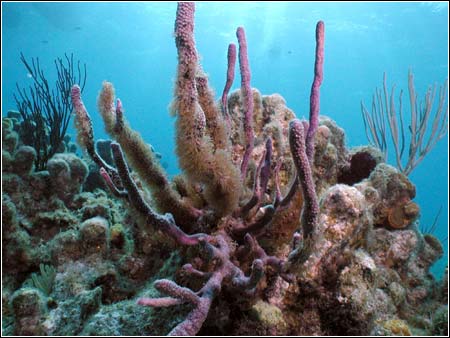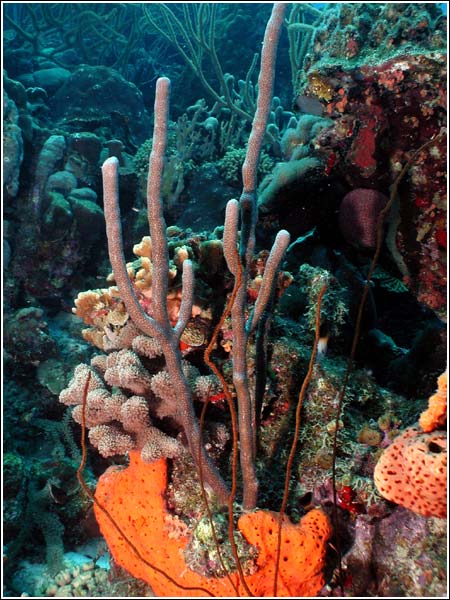Pool Exercises for Increasing Your Water Comfort
By Cameron L. Martz
 |
|
Photo by
Sonya Tittle
|
Important Safety Note: As with all waterborne activities, the
exercises to follow involve risk to your life. You are in direct
control of this risk. Always swim under the supervision of a
lifeguard or instructor, and stay within the bounds of your
fitness.
Nature vs. Nurture
Whether you believe that humankind crawled from the sea or was
created on dry land, we are not equipped by nature to stay
underwater for any appreciable length of time. We have strong
physiological and psychological reactions to being immersed,
especially in cold water, and these reactions can lead to
unnecessary stress or even panic.
Scuba equipment serves as a means of breathing and does little more to help us underwater. Only through training and time in the water can we develop the skills and experience needed to be comfortable with submersion. Luckily, there is much that we can do to improve our comfort and control in the water without the use of scuba.
Mouth Breathers
We are always breathing at least partially through our noses
while
 |
|
Photo by
Sonya Tittle
|
on the surface. The ability to breathe only through our mouths is therefore unnatural at first for many of us. Of course, wearing a well-cleared mask acts as a nose-clip of sorts, keeping our nasal passages dry and allowing us to draw entirely off the regulators in our mouths without any special effort. However, fill that mask with water, or remove it entirely, and we end up choking and setting our sinuses on fire unless we automatically shut off our noses.
Thus, one of the areas of focus in developing water comfort is mouth breathing. This must become instinctive in order for us to easily clear our masks, handle the occasional fin in the face, or survive the harassment of instructors and teammates.
Swimming the crawl (a.k.a., “freestyle”) is a great way to reinforce our ability to breathe properly for scuba while also increasing our fitness. With proper technique, a swimmer leaves much of his or her face submerged while inhaling, and totally submerged while exhaling. We learn to inhale only through our mouths without any mechanical assistance. We also gain comfort with our entire breath cycle occurring with our faces in the water.
For divers who have yet to master the crawl, snorkeling with goggles instead of a mask can serve as a good substitute. However, a snorkel allows us to breathe as we please without emphasizing the deep, rhythmic breath cycle that allows our lungs to most efficiently use the gas we breathe underwater.
We can also practice clearing our masks without the use of scuba. Just kneeling on the bottom of shallow water and learning to clear our masks several times on a single breath can greatly reinforce this skill, while teaching us to be more efficient while doing so.
Pre-scuba Exercises
Developing water comfort in a pool is not a new concept to military
divers. Most attend rigorous training, called
“pre-scuba,” in which their instructors
“drown-proof” them in a number of ways. Among these
are: being conditioned to swim at least fifty meters underwater on
a single breath; being thrown in the pool with their hands and feet
bound and forced to swim; being taught to buddy breathe with a
snorkel while being harassed by their instructors. This is all done
before they are allowed to proceed to what most of us experienced
in our first day of basic open water training.
Pre-scuba training instills confidence in military divers and introduces them to how chaotic diving can become. As civilians, we can gain some of the same experience, and confidence, by performing versions of the exercises done in pre-scuba military training in the convenience of our local swimming pool. All that we need is a buddy, a low-volume mask, a snorkel, booties and fins. [Note: If you have a snorkel with a purge valve, tape over the valve so you are forced to purge the water through the full length of the tube.]
 |
|
Photo by
Sonya Tittle
|
Snorkeling Gear Doff and Don
Preparation: For the purposes of this exercise, attach the snorkel
to the band of your mask. You must be able to open your eyes
underwater, so be sure to remove your contacts.
The Exercise: Find a pool deeper than you are tall and under direct supervision of a lifeguard. Put your booties on and drop your fins, mask and snorkel into the water. Hold your breath and dive down to your equipment. Put your mask on and clear it, put your snorkel into your mouth, and put your fins on your feet. Look up as you surface, slowly exhaling to clear the snorkel. Keep your face in the water and the snorkel in your mouth as you recover on the surface. Have your buddy in the water and watching you at all times.
Skill Developed: This exercise teaches efficiency of movement, as most will find that by moving more slowly, they are more likely to complete the exercise on a single breath.
Snorkel Buddy Breathing
Preparation: As the name implies, this exercise requires a buddy
and a snorkel. You and your buddy can wear masks at first. Try
switching to goggles or no eyewear at all to increase the
difficulty of this exercise.
The Exercise: Start in water that you can stand in. Lock onto your buddy’s arm to maintain contact, put your faces in the water, and begin buddy breathing. Take two controlled breaths before passing the snorkel, and exhale slowly while waiting your turn. Keep your face in the water the entire time; picking your head up is cheating. Practice this until you feel you can buddy-breathe indefinitely, and then move into deeper water.
Skill Developed: Of course, buddy breathing is a valuable skill in its own right, but this exercise reinforces more than that. Buddy team coordination, the ability to breathe calmly while under physical duress, and mouth-breathing are all strengthened by this exercise.
Survival Bob
Preparation: This exercise requires you to be able to sink to the
pool bottom without using any swim strokes. If you have trouble
doing so, you might need a ditchable weight belt. Use only enough
weight to help you get to the bottom. Never use more weight than
you can comfortably swim with on the surface, and make sure you and
the lifeguard on duty are familiar and practiced with ditching the
weight. Wear goggles if you are not comfortable opening your eyes
underwater, but do not wear a mask or nose-clip.
The Exercise: Find a pool deeper than you are tall and under direct supervision of a lifeguard. Clasp your hands together behind your back and keep your feet together as if they were bound. Slowly exhale while allowing yourself to sink feet-first to the bottom. When your feet touch bottom, recoil your legs slightly and spring off with just enough of a push for your face to break the surface. Continue exhaling all the way to the surface, then inhale and repeat. Practice until you feel you can bob indefinitely, and then move to deeper water.
Skill Developed: Exhaling through your nose and inhaling through your mouth, deep and rhythmic breathing, and efficiency of movement.
The Prisoner Swim
Preparation: You should already feel comfortable with the survival
bob before attempting this exercise.
The Exercise: Find a pool deeper than you are tall and under direct supervision of a lifeguard. Clasp your hands together behind your back and keep your feet together as if they were bound. Float facedown in the water and kick for propulsion, remembering to keep both legs together (this is known as a “butterfly” kick). Pick your head up to inhale on the third kick of every breath cycle.
The goal is to basically “worm” your way across the water. Even if your body is too dense to float, your kicking will keep you comfortably on the surface when done properly.
Skill Developed: Hopefully, you won’t find yourself tied up and kicked overboard. However, this exercise will refine your water confidence and improve your swimming ability.
The Results
Whether you’re just beginning your dive training or looking
to take your diving to a new level, it pays to get away from scuba
equipment and spend time in the pool. Practice these skills and
exercises until you are proficient, and you will have little
trouble handling future dive training.

